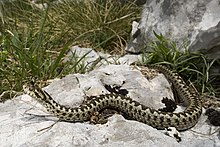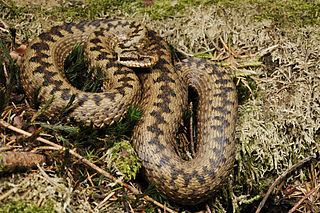
Vipera berus, also known as the common European adder and the common European viper, is a species of venomous snake in the family Viperidae. The species is extremely widespread and can be found throughout much of Europe, and as far as East Asia. There are three recognised subspecies.

Macrovipera lebetinus, known as the blunt-nosed viper, Lebetine viper, Levant viper, and by other common names, is a viper species found in North Africa, much of the Middle East, and as far east as Kashmir. Like all other vipers, it is venomous. Five subspecies are currently recognized, including the nominate race described here.

Vipera ammodytes, commonly known as horned viper, long-nosed viper, nose-horned viper, and sand viper, poskok is a species of viper found in southern Europe, mainly northern Italy, the Balkans, and parts of Asia Minor. Like all other vipers, it is venomous. It is reputed to be the most dangerous of the European vipers due to its large size, long fangs and high venom toxicity. The specific name, ammodytes, is derived from the Greek words ammos, meaning "sand", and dutes, meaning "burrower" or "diver", despite its preference for rocky habitats. Five subspecies are currently recognized, including the nominate subspecies described here.
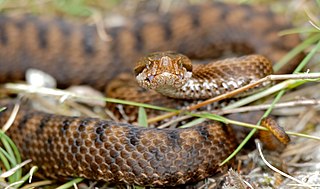
Vipera aspis is a viper species found in southwestern Europe. Its common names include asp, asp viper, European asp, and aspic viper, among others. Like all other vipers, it is venomous. Bites from this species can be more severe than from the European adder, V. berus; not only can they be very painful, but approximately 4% of all untreated bites are fatal. The specific epithet, aspis, is a Greek word that means "viper." Five subspecies are currently recognized, including the nominate subspecies described here.

Vipera kaznakovi, known as the Caucasus viper, Kaznakow's viper, Kaznakov's viper, and by other common names, is a species of venomous snake in the subfamily Viperinae of the family Viperidae. The species is endemic to Turkey, Georgia, and Russia. No subspecies are currently recognized.

Vipera latastei, known as Lataste's viper, the snub-nosed viper, and the snub-nosed adder, is a species of venomous snake in the subfamily Viperinae of the family Viperidae. The species is endemic to the Iberian Peninsula and northwestern Maghreb. Three extant subspecies and one extinct subspecies are currently recognized, including the nominate subspecies described here.

Vipera lotievi, commonly known as the Caucasian meadow viper, is a species of venomous snake in the family Viperidae. The species is endemic to Azerbaijan, Georgia, and Russia. There are no subspecies that are recognized as being valid.
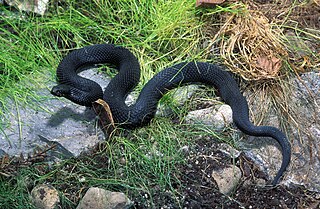
Vipera nikolskii is a venomous viper species endemic to Ukraine, eastern Romania, and southwestern Russia. No subspecies are currently recognized.

Montivipera raddei, also known as the Armenian viper and by many other common names, is a species of venomous snake in the subfamily Viperinae of the family Viperidae. The species is endemic to Armenia, Azerbaijan, Iran, Turkey, and possibly also Iraq. Two subspecies are currently recognized.
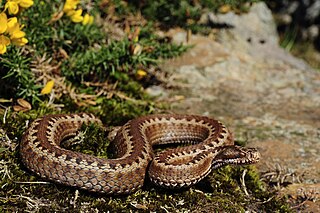
Vipera seoanei is a venomous viper species endemic to extreme southwestern France and the northern regions of Spain and Portugal. Two subspecies are currently recognized, including the nominate race described here.

Vipera renardi is a species of viper, a venomous snake in the family Viperidae. The species is endemic to Asia and Eastern Europe. Five subspecies are recognized.

Wagner's viper, known as the ocellate mountain viper, ocellated mountain viper, and Wagner's viper, is a species of venomous snake in the subfamily Viperinae of the family Viperidae. The species is native to eastern Turkey and northwestern Iran. There are no subspecies that are recognized as being valid.
Vipera eriwanensis, commonly known as the Alburzi viper or the Armenian steppe viper, is a species of venomous snake in the family Viperidae. The species is native to western Asia. There are two recognized subspecies.

The Hungarian meadow viper, also called the Danubian meadow viper is one of the eight subspecies of the Vipera ursinii. It is an extremely rare venomous viper that can mostly be found in Hungary. The Hungarian meadow viper is the most endangered species in the whole Pannonian Basin. It was scientifically recorded for the first time in 1893 by Lajos Méhelÿ, Hungarian zoologist. In 2004, its entire Hungarian population was estimated to be below 500 specimens.

Vipera graeca, commonly known as the Greek meadow viper, is a species of viper found in Albania and Greece, named after its presence in Greek meadows. As with all vipers, the Greek viper is venomous. The Greek viper was previously thought to be a subspecies of Vipera ursinii, but was elevated to species status as it has many morphological and molecular differences.
